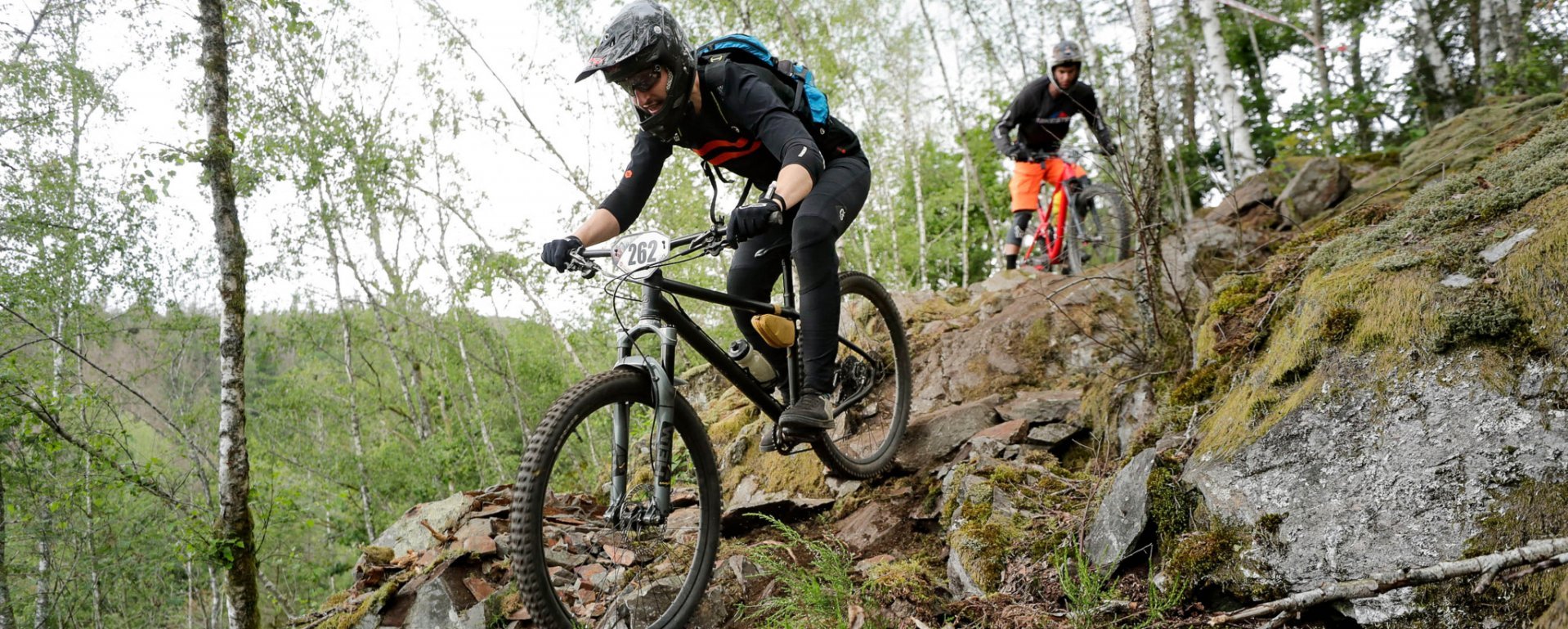
Product test: Thermoformable bike saddles from ...
A bike saddle that adapts to your anatomy? We have tested the thermoformable saddles from REFORM for you, which promise exactly that.
Backsweep? Upsweep? Rise? The handlebars let you adjust ride quality, comfort and ergonomics perfectly to you and your MTB. Read our tips to learn more.
It is not usually counted among the three classic contact points between rider and bike – and yet it is of paramount importance for off-road riding: the handlebars. There is hardly any other part that can improve handling, comfort and ergonomics so effectively and at such a low price.
The right set of handlebars on a mountain bike allows you to manoeuvre the bike safely and with a lot of control. It prevents your hands from getting tired or numb and can even help correct minor defects in your technique. However, which set of handlebars is best for whom? What do terms like backsweep, upsweep and rise mean for your riding experience?
The first step is to choose the appropriate handlebar width. The wider the handlebars, the greater the physical leverage: it results in higher pressure, more control and higher-precision steering movements. That's why MTB handlebar widths have grown steadily over the past two decades. More is not necessarily better, however, otherwise we would all be riding around with clothes rails a metre wide. The most common handlebar widths today are between 700 and 800 millimetres. As a general rule-of-thumb, the more technically demanding the application, the wider the handlebar ought to be. Cross-country or marathon racers often ride with handlebar widths measuring between 700 and 740 mm, as narrower usually translates to lighter. Trail, all-mountain or enduro riders like to opt between 740 and 780 mm for a balance of control, weight and manoeuvrability, while downhill and freeride mountain bikers like to ride 760 mm and wider for full control.

The field of application is not everything, however. Body size or shoulder width, terrain and mounted accessories also play a role in choosing the right set of MTB handlebars. The greater the shoulder width, the wider the handlebars that can be gripped comfortably should be. It can often become unpleasant when you feel like you have to spread your arms unnaturally. Even for people who frequently tackle narrow natural trails, "bigger" is not automatically "better". After all, the difference between 750 and 780 mm on a spruce slalom can make the difference between frustration and joy. Conversely, those who want to add extra accessories like bikepacking bags, lights or GPS devices will be happy to have a few extra centimetres. Speaking of extra inches: most MTB handlebars can easily be shortened by a few centimetres. The other way round is more difficult, even if you can eke out a few millimetres with grips with internal screw clamping like the Ergon GE 1 Evo. When in doubt, it is better to buy something wider and shorten it if necessary. By the way: if you swear by inner bar ends, you can also choose a slightly wider handlebar.
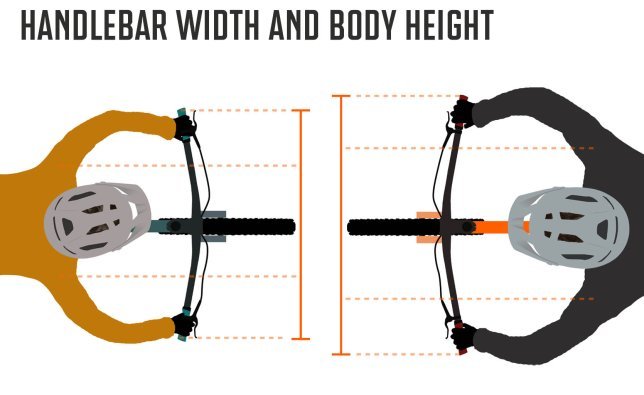
Like handlebar width, the rise of a handlebar is usually given in millimetres, and only very rarely in inches. The term refers to the height difference between the centre of the handlebar and the handlebar grips. Handlebars without rise are also called flatbars, while those with rise are called riser handlebars. The most common rise heights are between 0 and 30 mm; above that, they’re referred to as high-risers. Many manufacturers offer popular models in a wide variety of rise options. Exactly how much rise handlebars should have is a matter of taste, and also depends on the bike and the area of application. With handlebar rise you can easily adjust your desired cockpit height to the stack height, head tube length and fork height of your bike. In general, a low cockpit provides a lot of pressure on the front wheel and prevents it from rising when climbing. A higher cockpit makes your sitting position more relaxed and reduces the rollover sensation when going downhill. Expert tip: a high-riser is often a better alternative if you want to raise the cockpit, as it’s stiffer compared to spacers under the stem. Negative rise, i.e. drop, only plays an outsider role in mountain biking in contrast to gravel biking, for example in cross-country bikes one sees in the world cup.
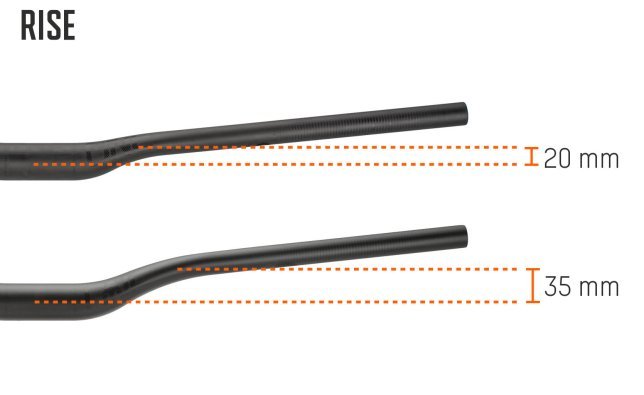
Closely related to the rise is the upsweep. This term refers to the upward bend of the handlebars, measured in degrees between the centreline of the handlebars and the grips. When it comes to upsweep, most handlebars resemble each other. Too much upsweep tilts the wrist inward by a lot. Values between three and eight degrees are common. Because the upsweep is strongly related to handlebar width and rise, some manufacturers do not specify it separately.
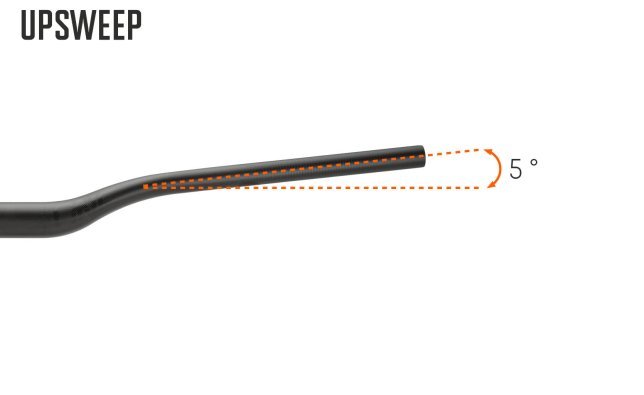
More exciting is the backsweep. It’s another angle, except this time the one bending the handlebars backwards. Ergonomically, the Backsweep opens up a wider playing field. A handlebar with a low backsweep between 5° and 8° facilitates a dynamic elbow position straight out of a riding technique textbook, giving you plenty of control over the front wheel and plenty of freedom of movement when absorbing waves or drops. At the same time, such a handlebar shape increases the load on the wrists. With that in mind, manufacturers such as Syntace or SQlab offer models with a relatively high backsweep of 12° or 16°, which should ensure a natural hand position and still provide enough pressure on the front wheel. For touring mountain bikers, bikepackers and other long-distance riders, there are also specialists like the Surly Terminal or the Moloko multi-position handlebar from the same company, each with a backsweep of 34°. But beware: in combination with a short stem, the ends of the grips can fall behind the middle of the stem.
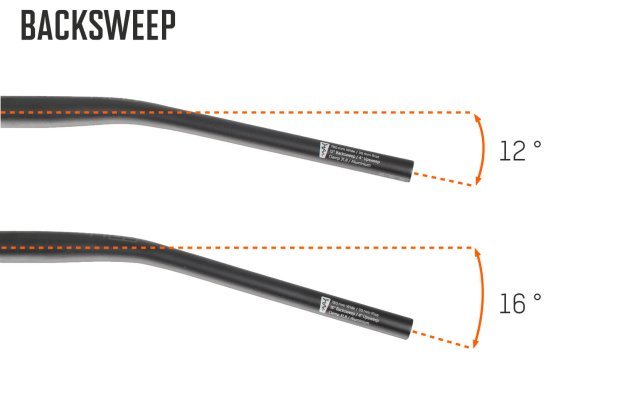
Just like with frames, Carbon and aluminium dominate the MTB world when it comes to handlebars. Assuming the same dimensions such as width, rise and handlebar clamping hold, a carbon handlebar is stiffer for the same weight, or lighter for the same stiffness than its aluminium counterpart. In addition, the high-tech material offers greater self-damping, which filters vibrations and reduces hand fatigue. However, carbon is also more expensive than aluminium. Pay attention during assembly: since the material reacts sensitively to compressed or bent fibres, a torque wrench is required here. Carbon assembly paste is also very useful for reducing the required clamping forces.
And why use aluminium when carbon is so good? The simple answer: aluminium is also an excellent handlebar material. With aluminium, you can build very stiff handlebars at a reasonable weight, which are also less sensitive to falls or intense loads. If you are constantly on the road with bikepacking bags, for example, which tend to rub dirt onto the handlebars under the attachment straps, you are definitely better off with aluminium. In addition, aluminium can be recycled almost as often as required, making it a fairly environmentally-friendly material despite the relatively high energy costs involved in its production. Last but not least, its price can’t be beat. Good handlebars like the LEVELNINE Riser are available for as little as 40 Euros.
Handlebars made of steel are used more in the lower price segment and in the touring sector due to their relatively high weight, despite their excellent stiffness and comfort values. However, exceptions like the Surly Cheater confirm the proverbial rule. Titanium handlebars such as the models from Thomson are, as with frame building, a much-beloved exotic: lightweight, beautiful, durable, desirable and expensive.
Mountain bike handlebars usually come in three clamping diameters: 25.4 millimetres, 31.8 millimetres and – relatively recently – 35 millimetres. The trend towards wider handlebars has historically led to an increase in clamping dimension. This is because the larger lever also means more stress on the material. That's why handlebars with a 25.4 millimetre stem clamp usually don't come much wider than 700 mm. Whether 31.8 or 35 millimetres, on the other hand, is more a matter of taste for most mountain bikers. If you are looking for maximum stiffness and control without increasing weight, go for the larger diameter. A little more flex and comfort is often offered by "the golden average" of 31.8 millimetres.
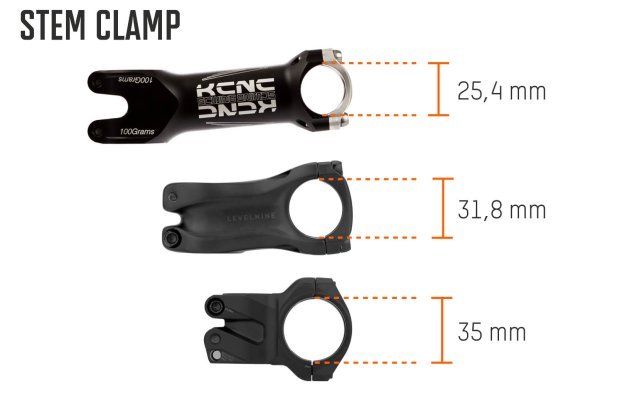
In terms of handlebar diameter on the grips, however, everything is quite straightforward. It is always 22.2 millimetres. You can ride grips with or without clamping, light XC grips, sticky downhill, stylish BMX or ergonomic grips. It’s your choice!
